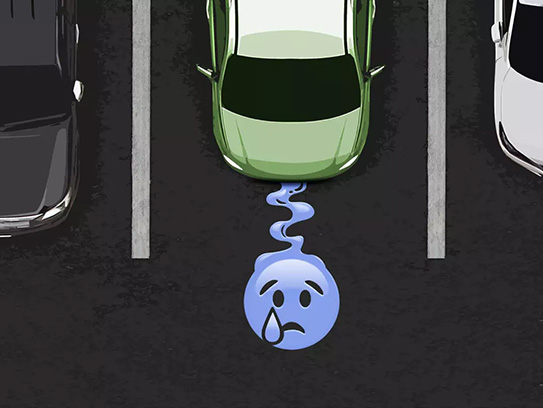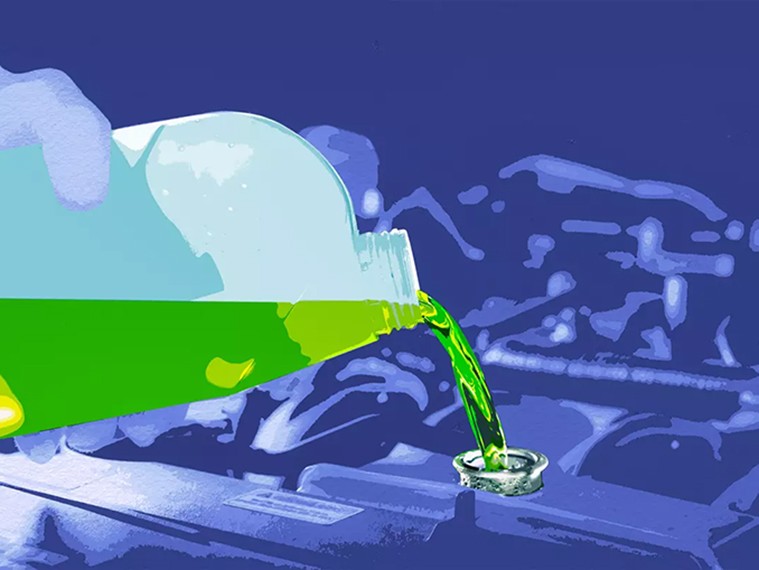As engines get very hot, coolant helps distribute heat to help prevent overheating and engine damage. It also adds antifreeze protection and acts as a lubricant for some of the engine’s components. If a vehicle’s cooling system only used water, the engine would freeze in cold temperatures, leading to cracking and failure.
There are two checks you can easily do on your coolant or the mixture of antifreeze and water: whether you have enough of it and if it’s still protecting your engine in cold temperatures. If you want to skip right to check whether you have enough, you can scroll down to “Checking Your Coolant Level.” If you want to skip testing your level of protection, you can scroll down to “Checking the Freezing Point.”
Useful Coolant Terminology and Facts
Antifreeze is mostly straight ethylene glycol or propylene glycol, which is very poisonous, while coolant is the result of mixing antifreeze with water, which you should always do.
Why should you always mix antifreeze and water? Because — against all logic — straight antifreeze will freeze at a higher temperature than the usual 50/50 mix of antifreeze and water. Furthermore, antifreeze doesn’t absorb heat from your engine as well as water does.
Although the specifics vary somewhat, the widely recommended solution of a 50/50 mix of antifreeze and water will freeze at about minus 35 degrees Fahrenheit. By contrast, straight antifreeze will freeze at about 0 to minus 20 degrees. While the best freeze protection comes with about 70% antifreeze — down below minus 50 degrees — you shouldn’t use anything stronger than 50/50 if you can get by with it due to the aforementioned problem with heat transfer, which can make your engine overheat.
Choosing the Right Antifreeze
Antifreeze comes in different colors, and you need to get the right one for your car. It used to always be green, but orange is now fairly common, and there are also other colors. If your owner’s manual doesn’t spell it out, your local auto parts store should be able to help you. You could also check the color when you check your vehicle’s coolant level, but it may have turned murky if it’s old, and it’s possible someone along the line added the wrong type.
Even what water you use is a concern. It is recommended to use distilled water in your radiator, not tap water, as it contains minerals that can harm your car’s cooling system. Few systems hold more than two gallons altogether, so a gallon of distilled water — which you can get at almost any store that sells bottled water — should suffice.
Although you shouldn’t have to add coolant to your system unless there’s a leak, it’s usually easiest to add a store-bought 50/50 “premix” if you do. Otherwise, since you don’t know how much you’ll need to add, you could end up with the wrong ratio of antifreeze and water.

Checking Your Coolant Level
There are two places under your hood to check the coolant level: the overflow tank (which some old cars may not have) and the radiator itself. If it’s not obvious, you can find the overflow tank by following the small-diameter hose that is attached to the radiator’s filler neck, just below the filler cap. The translucent overflow tank can usually be checked visually regardless of engine temperature, as there should be different levels marked on it for “Cold” and “Hot.”
Even if the coolant tank is at the right level — and especially if it’s low — you may want to check the coolant level in the radiator, as well. For that, the radiator needs to be cooled down, at least to the point you can leave your hand on it, because the cap you remove to check it holds a certain amount of pressure in the radiator, in part to help raise the boiling point of the coolant. If you suddenly release that pressure, the coolant can instantly boil and spray very hot coolant out like a geyser. If you check the level of coolant in the radiator, it should be right to the bottom of the filler's neck.

Checking Your Coolant’s Freezing Point
To check your coolant’s freezing point, you’ll need some sort of tester. Thankfully, simple ones, which usually look like a large eyedropper with little colored balls inside, aren’t very expensive; others might have a larger tank with a pointer inside and a big bulb on top. While the latter should be more accurate, the former will likely do.
To test, suction some coolant from either the overflow tank or the radiator then read the results. If it doesn’t indicate a freezing point you’re comfortable with, you can strengthen the coolant by adding straight antifreeze. If you need to remove some coolant to make room for the straight antifreeze, most radiators have a drain plug at the bottom facing the engine side. Note that you’ll need to run the engine for quite a while to mix everything together before testing again.
Coolant Additives
Many car manufacturers recommend replacing the coolant at certain intervals, often every two to five years. (Although some — and some types of antifreeze — may be “lifetime.”) That’s partly because antifreeze contains additives that reduce corrosion in the cooling system and help lubricate the water pump, and these additives wear out over time. You should follow the automaker’s recommendation, particularly for newer cars, as neglecting to do so may void the engine warranty.













